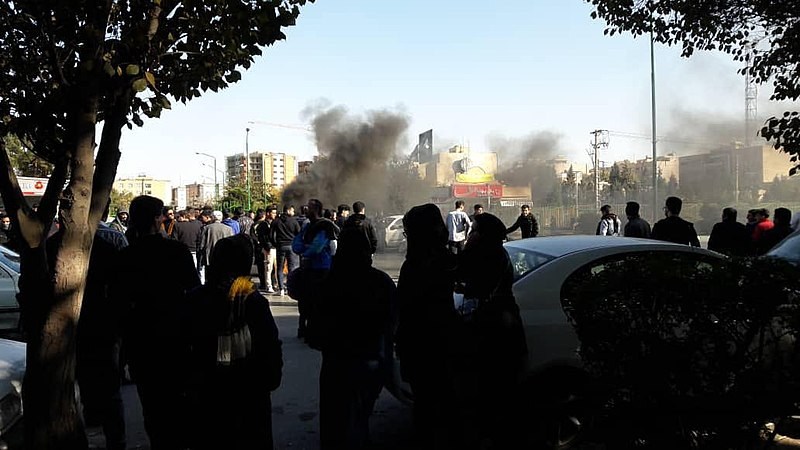Since last month, a new wave of protests have started in the Middle East.
Firstly, Iraqis were fed up with their corrupt government and demonstrated for a few weeks to take the government down. The president of Iraq, Barham Salih, asked the prime minister, Adil Abdul-Mahdi, to resign. As long as the Iraqi government is totally under the control of Iran, Adil Abdul-Mahdi refused to resign. Then with massive oppression of protesters, the Iraqi government thought they could stop the protests.
After several days of peace in Iraq, the protesters returned to streets once more. This time, they were more determined. They are completely aware of the role of the Iranian regime and their backed militias, Hashdalshabi, in Iraq. Consequently, the protesters strongly focused on the interference of the Iranian regime in their country. Iraqis chanted directly against supermen leader of Iran, Ayatollah Ali Khamanei, and Qasem Soleimani, the chief of Quds force, the IRGC arm for foreign missions.
Meanwhile, in Lebanon, protesters occupied the streets. Although Hezbollah in Lebanon receives a lot of support from the Iranian regime, they could not oppress the protesters. Finally, Saad Hariri, the prime minister of Lebanon, resigned.
The situation in Iran seemed stable and calm if we neglected daily minor strikes by retirees, workers in Haftape, Azarab in Arak. By the way, a big uprising at the national level was not foreseen. However, on Thursday night, 14 Nov 2019, the regime announced the new price for gasoline.
Such a decision to change the oil price was a gamble for the regime in Iran. They thought if they could control society, they could solve a large part of their financial problems by taking the money from Iranians who have suffered more than anyone else during these years. However, a few hours after this news, the Iranians came to the streets and started to block the roads. During the first night, the protests were mainly in Khuzestan, the province that has the most oil extraction sites in the country.
The uprising in Iran spreads
The day after, protests spread to 70 cities according to the NCRI (National Council of Resistance of Iran) network inside Iran. The angry Iranians started by blocking the main roads and streets in big cities such as Tehran, Tabriz, Isfahan, Shiraz, Karaj, Ahwaz, Mashad, Sanandaj and Behbahan.
The Islamic Revolutionary Guard Troops (IRGC) and police forces, controlled the situation for a few hours. After almost 2 or 3 hours the roads were blocked.
Police attacked protesters. Police started the attack using tear gas, water cannons, and batons. After arresting tens of protesters and killing 5 of them in different cities, the people had nothing to lose. Protesters fought the police officers back.
The other targets for the people was not difficult to guess- the banks. Iranians put fire to the banks; the organisation the regime uses to fund terrorism and oppression.
In Behbahan and Karaj more than 10 banks went on fire in each city. Overall, the Iranians set more than 100 banks on fire and Basij units during the second day of their protest. During the third day, the Iranian regime shut the internet down and very few clips were broadcast on social media. But NCRI confirms that the protests expanded to more than 100 cities and the people are resisting the massive oppression by police and IRGC.
The number of places that Iranians set on fire during just a day was more than the whole number of sites that were attacked during the two weeks uprising in 2017.
In a speech revealed by NCRI, a police commander asked his chief to send IRGC troops, otherwise 5,000 protesters will take over the government office in Robat Karim and the town will fall. In addition to that, Iran and IRGC news agencies confessed that protests are occurring in more than 100 places in the country.
They also confirmed that protesters are well trained, well organized and they know what they are going to do when they take to the streets.
NCRI and MEK stand for regime change
Maryam Rajavi the president-elect of NCRI expressed her condolences to the martyrs and wounded Iranians during the uprising and she also tweeted: “I urge the United Nations & all international #HumanRights organizations to strongly condemn the crackdown on the Iranian people’s demonstrations. I urge them to launch a mission to look into the circumstances of death, injury and arrests of participants in the uprising. #Iran.”
On 17 November 2019, just two days after the starting of the uprising, Ayatollah Khamenei, the supreme leader of Iran, made a speech to say that he fully supported the government in the increment of gasoline prices. Conversely, members of the Iranian parliament made several speeches to say that the parliament had no role in the increase and that they were not involved in the decision.
Masoud Ragavi, the founder of NCRI and the historical leader of MEK (Mojahedin e Khalgh) in his 16 statement about the uprising in Iran, clearly stated that the regime has no chance; either it can return the gasoline price to the previous value which opens the path for further uprisings in Iran, or continue on the same path by the Iranian regime which leads for more fire and nationwide protests.
After the uprising in December 2017 in Iran, Masoud Rajavi said that that uprising would lead to regime change in Iran and the regime cannot stop it any more. No matter how long it takes. Now, one year and a half after his statement another nationwide strike and protest is spreading through Iran.
International support
Outside of Iran, the US secretary of state, Mike Pompeo mentioned his tweet from a year and a half ago: “As I said to the people of Iran almost a year and a half ago: The United States is with you.” In addition, an official statement from the Press Secretary regarding protests in Iran fully supported Iranians in their battle with Mullahs.
Still, Europe has not clearly defended Iranians and it has not also condemned the Iranian regime for oppressing protesters and cutting the internet down. When 20 Iranians have been killed during peaceful protests, the European response has been vague.
What is Europe waiting for?
Clearly, according to NCRI, the Iranian regime has no future. Even if they succeed to suppress this uprising, obviously more unrest is waiting in line. Because the opposition to the Iranian regime (NCRI and MEK) has prepared well for such a day.
They have already introduced their leader, Mrs. Maryam Rajavi, their council made of several Iranian opposition groups and almost 500 members (NCRI), their freedom army (the residence of Ashraf 3 in Albania), and now, as a result, we can see the power of their resistance inside the country.
Europe cannot invest in a dead horse, Ayatollahs, any more.
The right action for Europe is to stand next to the people of Iran and their legitimate resistance.
The EU must take urgent action to stands for its values of democracy and freedom.
The EU must leave the Iranian nuclear deal now and not tomorrow, in order to prevent the regime from benefitting from the oppression of people because of its relationship with Europe. The EU must return all sanctions and extend the UN arms embargo.
This regime has proved that it is not able to behave like a normal country that listens to its people and has a constructive dialogue with other nations.
The EU must prevent Iranian banks from accessing its network. Protesters in Iran have set on fire banks through which the regime fuels terrorism and oppression. Allowing the Iranian regime access to use the banking system in Europe means endangering Europeans by funding terrorism.
Europe must close Iran’s embassy, which are acting as terror cells in Europe.
And, finally, the last and the most important action by Europe is to recognize NCRI as the legitimate alternative to the Iranian regime. Therefore, Europe guarantees to protect protesters, democracy and human right in Iran, and it can also construct a sustainable relationship with a new generation there. The nation that has been seeking democracy for more than a century.
Ali Bagheri


